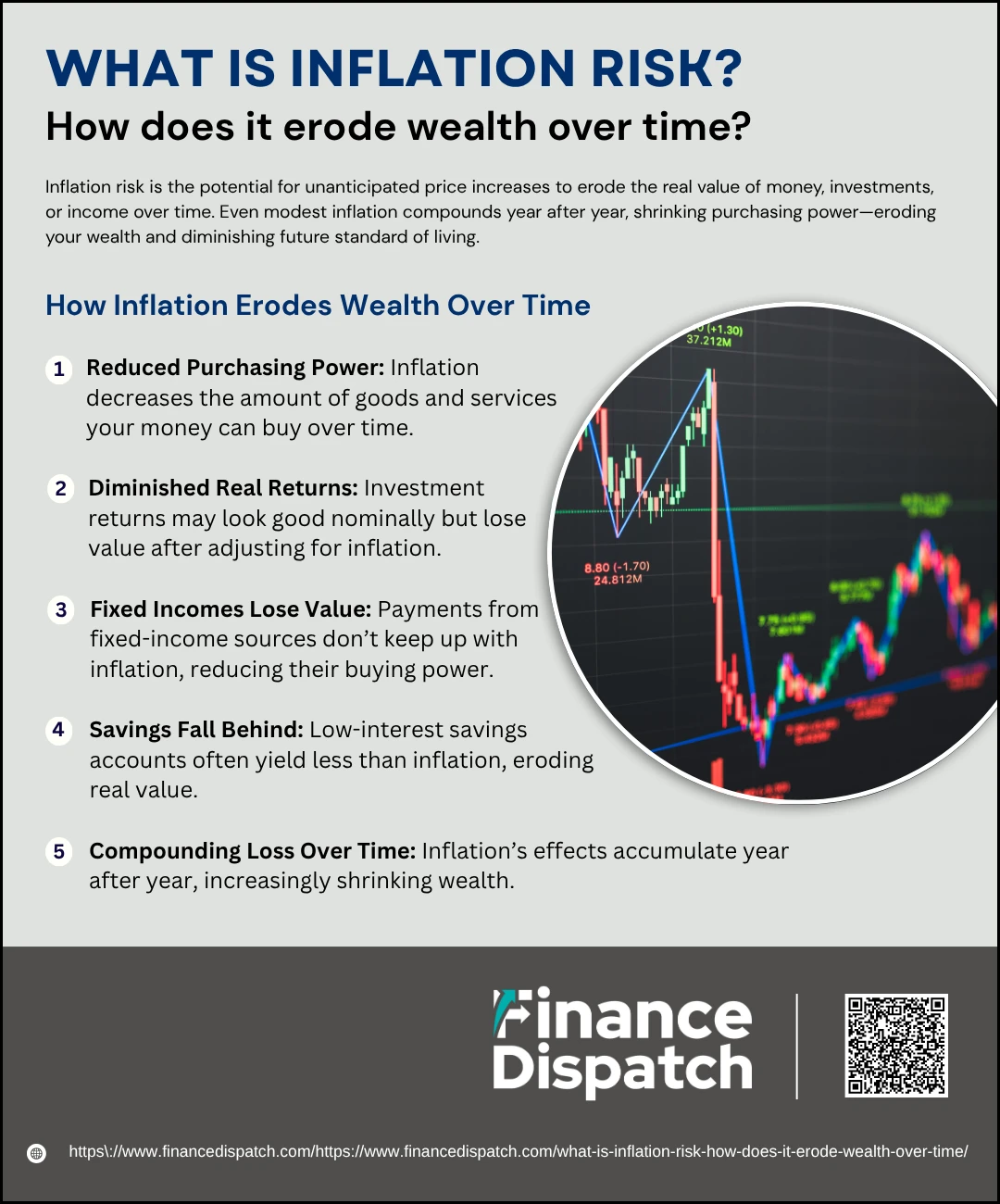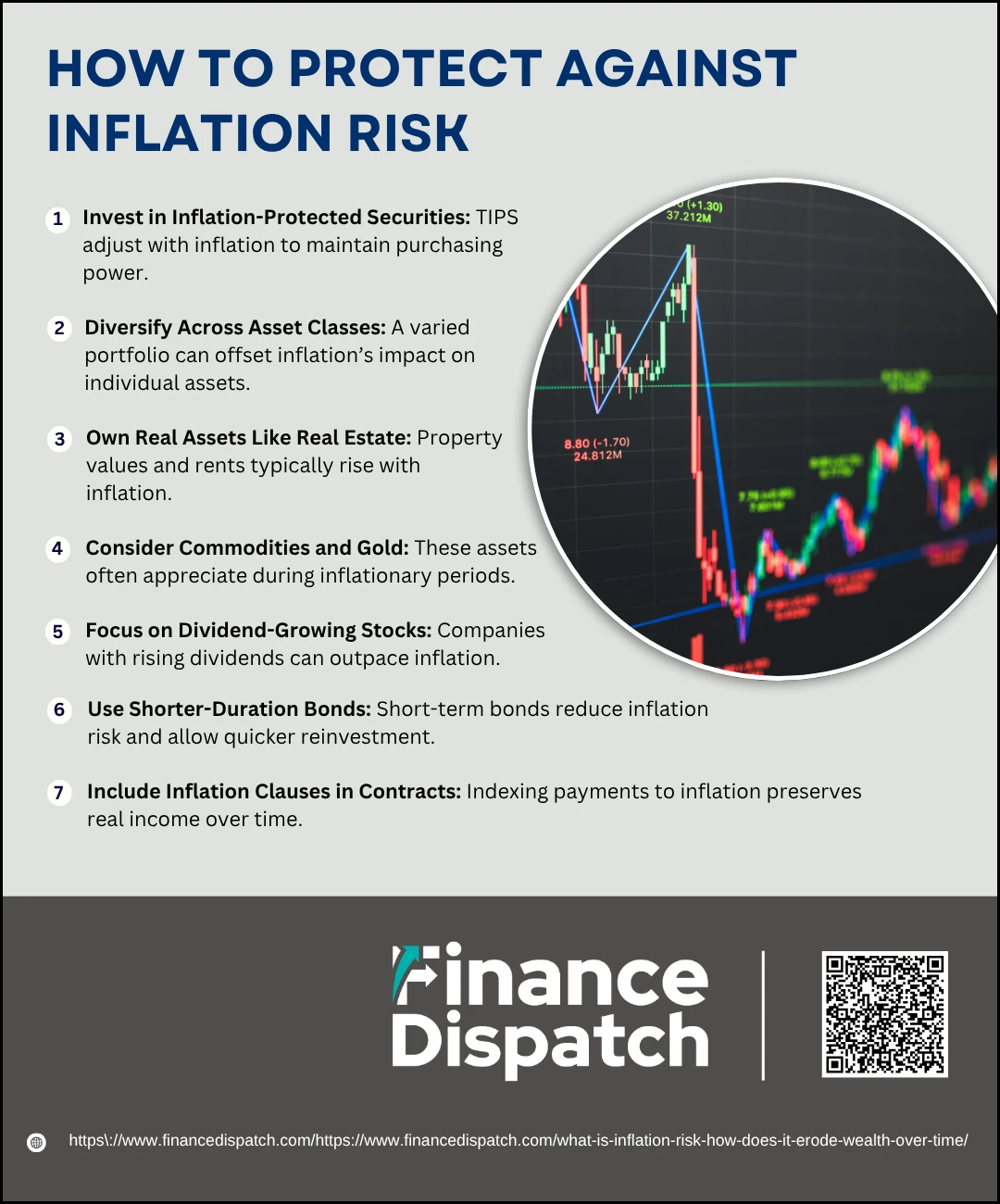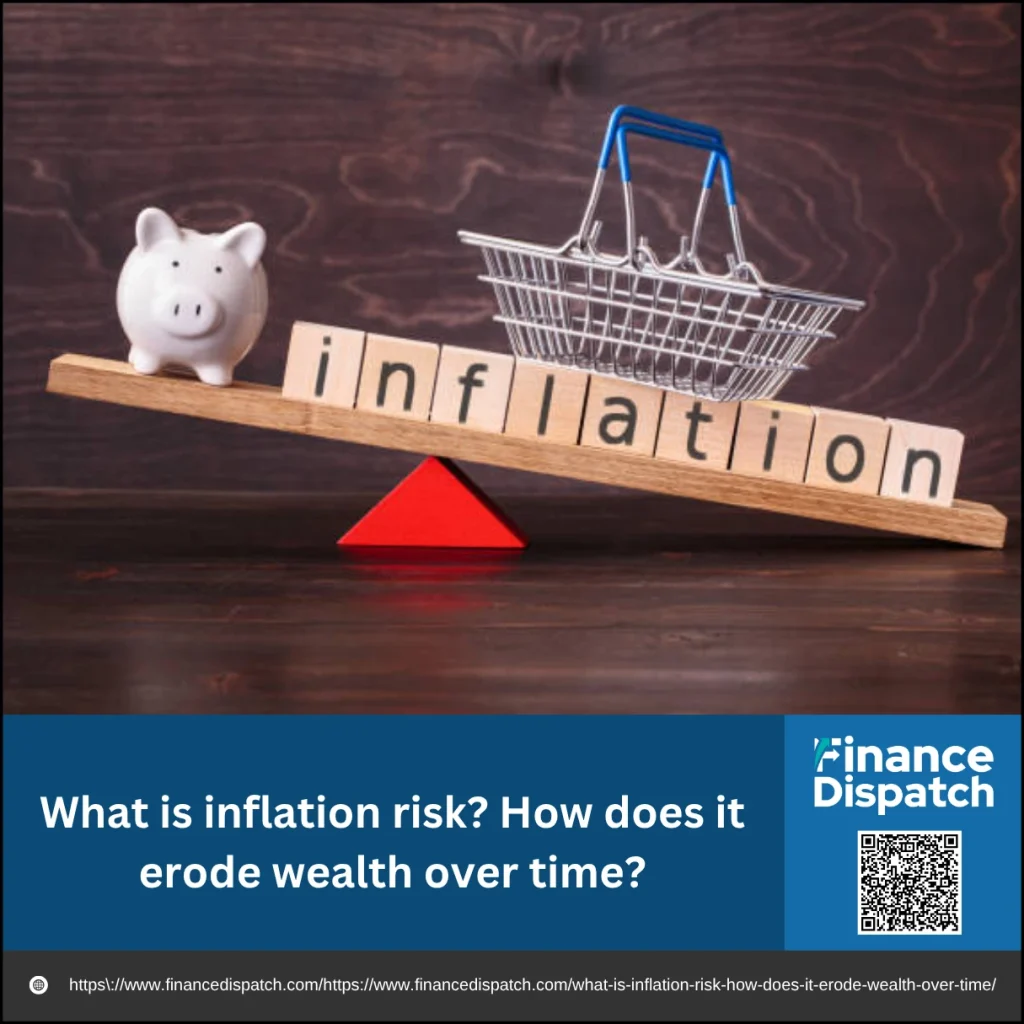Inflation risk is a silent threat that can steadily erode your wealth without you even realizing it. As prices rise over time, the money you’ve saved or invested may not stretch as far, reducing your purchasing power and the real value of your returns. Whether you’re planning for retirement, managing a business, or simply saving for the future, understanding inflation risk is essential. This article explores what inflation risk is, how it works, and why it matters in protecting your financial well-being.
What is Inflation Risk?
Inflation risk, also known as purchasing power risk, refers to the possibility that the value of money will decrease over time due to rising prices of goods and services. As inflation increases, each unit of currency buys fewer items, which means that the real value of savings, investments, or fixed incomes diminishes. This risk is particularly concerning for long-term financial plans, as it can quietly undermine wealth by reducing the future value of money. For individuals, businesses, and investors alike, understanding inflation risk is crucial for making informed financial decisions that preserve value over time.
Why Inflation Risk Matters
Inflation risk matters because it directly affects your ability to maintain purchasing power and achieve long-term financial goals. When inflation rises, the money you’ve saved or invested loses value, meaning you can afford less with the same amount over time. This is especially problematic for fixed-income investments and savings accounts that do not grow in line with inflation. For retirees, businesses, and investors, ignoring inflation risk can lead to a significant shortfall in expected returns or income. Addressing this risk is essential to preserving wealth, sustaining living standards, and ensuring financial stability in the face of rising costs.
 How Inflation Erodes Wealth Over Time
How Inflation Erodes Wealth Over Time
Inflation may not feel like an immediate threat, but over time, it quietly chips away at your financial stability. As prices for everyday goods and services rise, the same amount of money buys less than it used to. This gradual decline in purchasing power can significantly impact your savings, investments, and overall wealth—especially if your financial growth doesn’t keep pace with inflation. Here’s a closer look at how this erosion unfolds:
1. Reduced Purchasing Power
As inflation increases, each dollar you hold buys fewer goods and services. For example, with a 3% annual inflation rate, something that costs $100 today will cost $103 next year. Over a decade, this can dramatically shrink what your money can buy.
2. Diminished Real Returns
Investment gains may appear strong on paper, but when adjusted for inflation, the real return could be much lower—or even negative. For instance, a 5% return in a year with 4% inflation only nets a 1% real return.
3. Fixed Incomes Lose Value
Fixed-income sources such as pensions, annuities, or bonds offer set payouts that don’t adjust with inflation. Over time, these payments lose their buying power, making it harder to cover everyday expenses, particularly for retirees.
4. Savings Fall Behind
Money kept in traditional savings accounts or low-yield instruments often earns interest rates below the inflation rate. This means that while your account balance might grow slightly, its real-world value declines year after year.
5. Compounding Loss Over Time
The effects of inflation aren’t just one-time losses—they compound. Year after year, the gap between your money’s growth and the rising cost of living widens, leading to a significant erosion of wealth if proactive measures aren’t taken.
Key Economic Drivers of Inflation Risk
Inflation doesn’t happen in a vacuum—it’s driven by a complex mix of economic forces that influence the price of goods and services over time. Understanding these key drivers can help individuals and businesses better anticipate and manage inflation risk, protecting their financial stability in the long run. Below are the main economic factors that contribute to inflation and its associated risks:
1. Supply and Demand Imbalances
When demand for products or services exceeds supply, prices tend to rise, creating inflationary pressure.
2. Monetary Policy
Central banks, such as the Federal Reserve, influence inflation through interest rates and money supply. Low interest rates and increased money circulation can trigger inflation.
3. Fiscal Policy
Government spending and tax policies affect overall economic activity. Excessive spending without equivalent revenue can lead to inflation by fueling demand.
4. Exchange Rate Fluctuations
A weakening national currency makes imports more expensive, which can drive up domestic prices and increase inflation risk.
5. Commodity Prices
Sharp increases in essential commodities like oil or food can cause widespread price hikes across industries, adding to inflationary pressure.
6. Wage Growth
Rising wages can lead to increased production costs for businesses, which are often passed on to consumers in the form of higher prices.
7. Global Economic Disruptions
Events like supply chain breakdowns, pandemics, or geopolitical conflicts can constrain supply or alter demand, contributing to inflation volatility.
Real-World Examples of Inflation Risk
Inflation risk isn’t just a theoretical concern—it has played a significant role in shaping economies, investment strategies, and household finances throughout history. Real-world examples help illustrate how inflation can disrupt markets, erode wealth, and challenge economic stability. These cases highlight the importance of understanding and preparing for inflation risk.
1. 1970s Oil Crisis (Stagflation in the U.S.)
A sharp rise in oil prices led to a combination of high inflation, stagnant economic growth, and rising unemployment—a rare and damaging economic scenario known as stagflation.
2. Hyperinflation in Zimbabwe (Late 2000s)
Zimbabwe experienced extreme inflation, with prices doubling every day at one point. The local currency became nearly worthless, devastating savings and crippling the economy.
3. Germany’s Weimar Republic (1920s)
Post–World War I reparations and uncontrolled money printing led to hyperinflation, where people needed wheelbarrows of cash to buy basic goods like bread.
4. Post-COVID Economic Recovery (2020s)
Stimulus spending, supply chain disruptions, and rapid demand recovery led to inflation spikes across many countries, prompting central banks to raise interest rates aggressively.
5. Consumer Electronics Price Trends
While tech products often see price drops due to innovation, inflation in raw materials and supply chain bottlenecks can still cause unexpected price increases in final goods.
 How to Protect Against Inflation Risk
How to Protect Against Inflation Risk
Protecting your finances from inflation risk means more than just earning interest or chasing high returns—it’s about preserving the real value of your money over time. As inflation rises, the cost of living increases and the purchasing power of your cash or fixed-income investments shrinks. Without proper planning, long-term financial goals such as retirement, education savings, or business sustainability can be undermined. The good news is that there are proven strategies you can use to guard against this erosion. Below are effective ways to protect your wealth from inflation risk:
1. Invest in Inflation-Protected Securities
Treasury Inflation-Protected Securities (TIPS) are U.S. government bonds whose principal and interest payments adjust based on changes in the Consumer Price Index (CPI). These instruments help ensure that your investment keeps pace with inflation, making them a reliable choice for conservative investors.
2. Diversify Across Asset Classes
A well-diversified portfolio spreads risk and reduces exposure to any single asset. Including a mix of equities, real estate, commodities, and inflation-linked securities helps ensure that some parts of your portfolio will perform well even when inflation rises.
3. Own Real Assets Like Real Estate
Real estate is one of the most common hedges against inflation. Property values generally increase over time, and landlords can adjust rent rates upward to keep up with inflation, ensuring steady and inflation-adjusted income.
4. Consider Commodities and Gold
Commodities such as oil, gas, wheat, and metals often see price increases during inflationary periods. Gold, in particular, has a long history of serving as a store of value and is widely regarded as a traditional inflation hedge.
5. Focus on Dividend-Growing Stocks
Companies that consistently grow their dividends tend to have strong fundamentals and pricing power, allowing them to maintain profitability and shareholder returns even when costs rise.
6. Use Shorter-Duration Bonds
Long-term bonds are more vulnerable to inflation because their fixed payments lose value over time. Shorter-term bonds mature faster, allowing investors to reinvest at higher yields that reflect the current inflation environment.
7. Include Inflation Clauses in Contracts
For individuals and businesses engaged in long-term agreements, including inflation-indexed adjustments in contracts (such as lease agreements or service contracts) ensures that earnings or payments maintain their value over time.
Measuring and Calculating Inflation Risk
Understanding how to measure and calculate inflation risk is essential for making informed financial decisions. Inflation doesn’t just impact prices—it affects your investments, savings, and long-term financial goals. By using specific economic indicators and financial formulas, you can estimate how much inflation might erode your purchasing power and what real returns you can expect from your assets. Below are some of the most common tools and methods used to gauge inflation risk:
1. Consumer Price Index (CPI)
The CPI tracks changes in the prices of a standard basket of goods and services over time and is the most widely used measure of inflation.
2. Real Rate of Return
This calculates the actual return on an investment after adjusting for inflation using the formula:
(1 + Nominal Return) ÷ (1 + Inflation Rate) − 1
3. Break-Even Inflation Rate
This is the difference between the yields of nominal government bonds and inflation-protected bonds, showing market expectations for future inflation.
4. Fisher Equation
This formula links nominal interest rates, real interest rates, and expected inflation:
(1 + Nominal Rate) = (1 + Real Rate) × (1 + Expected Inflation)
5. Inflation Risk Premium
This is the extra return investors demand for bearing the uncertainty of unexpected inflation. It’s calculated by subtracting the real yield and expected inflation from the nominal yield.
Strategies to Mitigate Inflation Risk
Mitigating inflation risk is crucial for preserving the value of your money and ensuring long-term financial stability. As inflation rises, it can quietly diminish the real returns on your investments and the purchasing power of your savings. Fortunately, there are practical strategies that individuals and businesses can adopt to reduce their exposure to inflation and protect their financial assets. Below are some effective methods:
1. Diversify Your Investment Portfolio
Spreading investments across various asset classes—such as stocks, real estate, commodities, and inflation-protected securities—helps minimize the impact of inflation on your overall returns.
2. Invest in Treasury Inflation-Protected Securities (TIPS)
These U.S. government bonds are specifically designed to adjust with inflation, making them a reliable option for preserving purchasing power.
3. Include Real Assets Like Real Estate
Property values and rental income often increase with inflation, offering both asset appreciation and income protection.
4. Consider Commodities and Precious Metals
Commodities like oil and gold typically rise in value during inflationary periods, serving as natural hedges against rising prices.
5. Shorten Bond Maturities
Holding short-term bonds allows investors to reinvest at higher interest rates as inflation rises, reducing exposure to long-term inflation risks.
6. Use Inflation-Indexed Contracts
For businesses, including inflation clauses in long-term agreements (like leases or service contracts) helps maintain income levels despite rising costs.
7. Invest in Growth-Oriented and Dividend-Increasing Stocks
Companies with strong pricing power and a history of growing dividends tend to perform better in inflationary environments.
Inflation Risk and Retirement Planning
Inflation risk plays a critical role in retirement planning because it directly affects the long-term value of savings and fixed income streams. As the cost of living rises, retirees may find that their money doesn’t stretch as far as it once did—especially if their income sources, such as pensions or annuities, are not inflation-adjusted. Over time, even modest inflation can significantly reduce purchasing power, making it harder to cover essential expenses like healthcare, housing, and daily needs. To maintain financial security in retirement, it’s essential to include strategies that account for inflation, such as investing in assets that typically outpace inflation, incorporating Treasury Inflation-Protected Securities (TIPS), and considering income products that adjust with the Consumer Price Index (CPI). Without proper planning, inflation can quietly undermine the financial comfort retirees have worked a lifetime to build.
Conclusion
Inflation risk is an unavoidable part of any long-term financial plan, yet it often goes unnoticed until its effects are deeply felt. Over time, rising prices can quietly erode the value of your savings, investments, and fixed incomes, compromising your ability to maintain your standard of living. By understanding what drives inflation and how it impacts various financial assets, you can take proactive steps to protect your wealth. Through diversification, inflation-protected investments, and strategic planning—especially for retirement—you can reduce exposure to inflation risk and preserve your financial well-being for the future.



